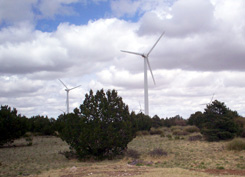NEWS RELEASES
FOR IMMEDIATE RELEASE
May 20, 2008
Wind farm may be on the way for Sandia, Kirtland Air Force Base
Wind Department seeks industry interest in a 30-MW farm on base

This wind farm on the Aragonne Mesa southwest of Santa Rosa, N.M. is
similar to the type that might be built on Kirtland Air Force Base.
Download 300dpi 6.42MB JPEG image (Media are welcome to download/publish this image with related news stories.)
ALBUQUERQUE, N.M. — Sandia National Laboratories and Kirtland Air Force Base may soon share a wind farm that will provide as much as one-third of the electricity used by the two entities.
The Labs’ Wind Energy Technology Department and the U.S. Department of Energy Wind and Hydropower Technologies Program have embarked on a project to determine if such a plant is viable and to build a roughly 30-megawatt (MW) farm on the air base. A private company would design, build, and operate the farm, and DOE/National Nuclear Security Administration, Sandia and Kirtland would buy the electricity.
Wind Energy Department Manager Jose Zayas says the project — called Sandia Wind Farm Feasibility Project — is part of the DOE Transformational Energy Action Management (TEAM) initiative. According to Energy Secretary Samuel Bodman, the TEAM initiative goal is to “maximize installation of secure, on-site renewable energy projects at all DOE sites.” In addition to installing renewable energy, other DOE goals are to reduce energy use by 30 percent and use third parties to finance the projects. The project would also be a way to reduce energy intensity and greenhouse gas emissions, increase use and efficiency of renewable energy technologies, and adopt sustainable design practices as called for in President Bush’s January 2007 Executive Order 13423.
Sandia is a National Nuclear Security Administration laboratory.
A Request For Information (RFI) was recently placed on a Sandia procurement website in an effort to make commercial, utility-scale wind farm developers, owners, operators, energy service companies, and financiers aware of the potential opportunity to build a wind farm on the base. Deadline to respond to the RFI and be eligible to compete for the partnership is July 3.
In addition, Sandia is holding an “Industry Day” on June 10 in Albuquerque where interested developers can obtain information and ask questions. At the meeting Brian Connor of DOE’s Wind and Hydropower Technologies Program will address the federal goals and objectives of the TEAM initiative and how they will apply to other DOE sites, including Sandia. The location and time of the meeting will be announced on the Wind Energy Technology Department website at www.sandia.gov/wind.
Project engineer Roger Hill says this project is highly unusual for a variety of reasons.
“Usually, private companies build wind farms to sell power to utilities or utilities install wind turbines for their own system use,” Hill says. “Here we are looking for a private company to build a wind plant on federal land for federal [Sandia and Kirtland] consumption.”
The initial stage of the project will involve investigating the feasibility of building the farm on federal lands and/or the adjacent Isleta Pueblo. In the next couple of months Sandia will install a meteorological station on a ridgeline in the Manzano mountains near Albuquerque to measure wind speed and direction. A second will follow.
Hill says that the Manzano mountain site is believed to be one of the best locations of all DOE facilities for a wind farm. Its wind yield is in an indicated class 5 or 6 on a scale of 1 to 7, falling just short of superb.
As part of the feasibility effort, the study team will spend a year assessing the wind characteristics, as well as looking at accessibility to transmission lines, base substations, and PNM’s Sandia switching station. Hill anticipates that as the feasibility study moves along, issues will be identified that will need to be addressed. For instance, the wind turbine installation or operation might conflict with current or planned base operations. Also, an environmental assessment must be performed to ascertain and perhaps mitigate impacts on wildlife.
Together Sandia and KAFB use 72 MW during peak loads and about 40-50 MW at any given time. Sandia’s share of the electricity usage is about 60 percent and Kirtland’s is 40 percent. If a wind farm is built, the two may split the electricity produced in the same 60-40 equation. Construction time from inception to finish could be as little as two years.
Wind farms in New Mexico are located in Guadalupe County (Aragonne Mesa), Quay County (Caprock Wind Ranch, Phases I and II), Roosevelt County (San Juan Mesa), and Quay and DeBaca counties (New Mexico Wind Energy Center).
Zayas says the idea of a Sandia/Kirtland wind farm “is as exciting as it gets” because it provides the opportunity to showcase Sandia and be one of the first DOE sites to have a utility-scale wind farm where power is being consumed.
“This is a pioneering effort that meets the national initiative for renewable energy deployment,” he says. “Plus it contributes to our self-sufficiency and sustainability. We are using a natural indigenous resource to meet our own needs. And it can be replicated elsewhere. It’s a big deal.”
Sandia is a multiprogram laboratory operated by Sandia Corporation, a Lockheed Martin company, for the U.S. Department of Energy’s National Nuclear Security Administration. With main facilities in Albuquerque, N.M., and Livermore, Calif., Sandia has major R&D responsibilities in national security, energy and environmental technologies, and economic competitiveness.
Sandia news media contact: Christine Burroughs, coburro@sandia.gov,
(505) 844-0948